|
|
|
|
The Vendor Invoices (VI) screen is used by the accounting department to enter vendor invoices received for processing. This screen can also be used to enter vendor invoice adjustments (i.e., positive or negative values). Transactions entered here can be charged to all accounts that are valid for data entry in the specified Legal Entity including accounts that require project information.
After posting a vendor invoice, the document can be voided which will create a new document that is the negative of the original document. The voiding document should be treated the same as if it had been applied to the original document.
Vendor Invoices can be related to one Purchase Order (PO). You can relate the VI to a Purchase Order on the Vendor Invoice Summary page. If the VI is related to a PO, field values may be restricted based on values included from the PO. If the PO has a Receiver/Approver assigned to it, then that Receiver/Approver will be assigned as an approver of the VI for the detail lines related to the PO, regardless of approval group settings.
Using the Vendor Invoices search / list screen, you can search for and view existing entries, and select the option to download invoices as PDFs (available for Cloud customers only). From this screen, users can also create, edit, post (previously submitted) and void Vendor Invoices. Vendor Invoices can have one of the following statuses: INUSE, SUBMITTED, APPROVING, APPROVED, POSTED, or DISAPPROVED.
For intercompany efforts, users with appropriate access can select organizations that belong to the legal entity specified in the multi-entity structure defined in Setup Multi-Entity Associations. This allows vendor invoices to support intercompany invoices so that the vendors can be paid and the funds can be allocated across the organizations identified in the intercompany structure.
Note: Vendor Invoices that have a status of SUBMITTED will be changed to APPROVED during the migration process from 10.3 to 11.0 version. This is due to the change in 11.0 where the status must go from SUBMITTED to APPROVED and then to POSTED. Without this change in the migration, pre-migration Vendor Invoices that were in SUBMITTED status would not be able to be POSTED.
This screen is available to users having any of the following roles: Administrator, AP User, AP Viewer, AP Poster, or VI User.
This screen is available with the Project Financials family of Unanet licenses.
Topics covered on this help page include:
Search (to refine the list of Vendor Invoices; print option for invoices )
List (to view, edit, delete, void or post Vendor Invoices)
Add (to add Vendor Invoices)
Edit
Summary (to edit Vendor Invoice summary information)
Details (to edit Vendor Invoice details)
Attachments (to add attachments to a Vendor Invoice)
Matched
View (to see a view only copy of a Vendor Invoice)
Copy (to copy Vendor Invoices)
Post (to post Vendor Invoices)
Void (to void Vendor Invoices)
Closed Fiscal Year (adjusting entries when posting/voiding to a closed fiscal year)
You may also be interested in:
Accounts Payable Approvals (Vendor Invoice approvals)
AP Admin Guide - Vendor Invoice Entry (search for this topic in the Knowledge Center)
AP Admin Guide - VI Approvals (search for this topic in the Knowledge Center)
FAQ - How can I quickly post many recurring vendor invoices? (search for this topic in the Knowledge Center)
FAQ - Does Unanet have a Vendor Invoice Edit (GCS Voucher Edit Report)? (search for this topic in the Knowledge Center)
Using the Vendor Invoice Search screen, you can refine the list of Vendor Invoices with which you have interest, by supplying search criteria and clicking on the List tab.
In order to generate a PDF of the invoice, select the Print all selected vendor invoices option on this page (available for Cloud customers only). Then select the invoices on the List page and click Print at the bottom of the page. See Print Vendor Invoice field description for more information.

|
|
|
Note: Users having only the VI User role will not see these filter fields: Organization, AP Account, Creator, Modifier, Submitter, and Poster.
The resulting list will resemble the following example. From this screen, you can use the available options to view, edit, delete, post, print, or void a particular Vendor Invoice.
Drill Down Note: You can click on the value in the Balance column to view the Vendor Invoice Balance Details popup report. The value in the Balance column is calculated as follows:

|
|
|
Vendor Invoice - Balance Details Popup
The Vendor Invoice - Balance Details Popup report will resemble the following:

Clicking on the  link (available on the Vendor Invoice - Search/List screens), will present you with the Vendor Invoice - Summary screen where you will supply the summary information for a Vendor Invoice. Subsequent to providing the summary level information, you will then need to navigate to the Details option, and supply Vendor Invoice detail line items. On this Summary screen, you will enter information regarding the Vendor that sent the invoice, payment options, accounts payable information, the document and post dates, whether this is a recurring entry, whether there should be a payment hold, and any comments you'd like to associate with the entry.
link (available on the Vendor Invoice - Search/List screens), will present you with the Vendor Invoice - Summary screen where you will supply the summary information for a Vendor Invoice. Subsequent to providing the summary level information, you will then need to navigate to the Details option, and supply Vendor Invoice detail line items. On this Summary screen, you will enter information regarding the Vendor that sent the invoice, payment options, accounts payable information, the document and post dates, whether this is a recurring entry, whether there should be a payment hold, and any comments you'd like to associate with the entry.
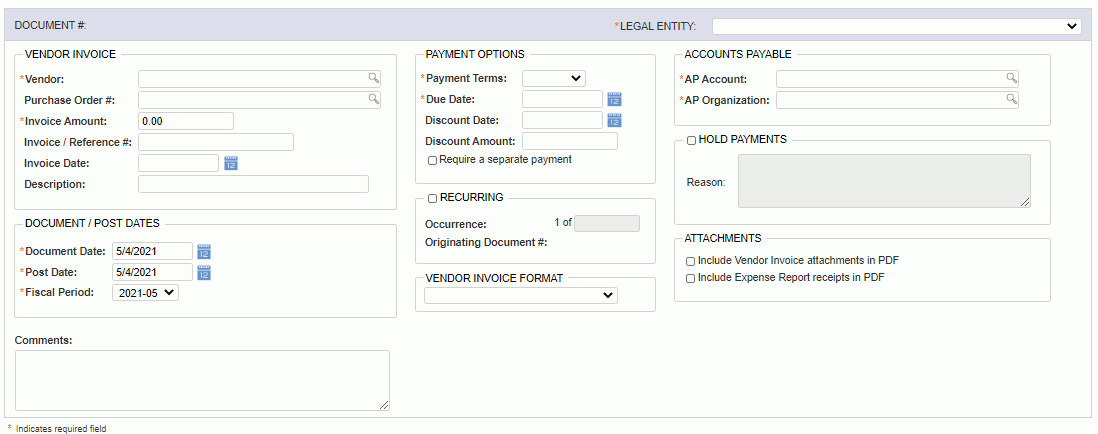
|
|
|
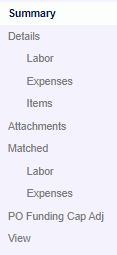
The Edit Vendor Invoice screen (which you can get to by navigating to the Summary left menu option after clicking the pencil icon from the Vendor Invoice list screen), is nearly identical to the Vendor Invoice Add screen. On this screen you can modify most fields with the exception of Legal Entity (which can no longer be modified once any Detail line items have been added to this Vendor Invoice). This screen also displays the Vendor Invoice Document # assigned to this Vendor Invoice and also includes a Totals section, which recaps the amounts currently entered for any Detail line items.
The Summary menu option will become unavailable once the Vendor Invoice reaches the POSTED status.
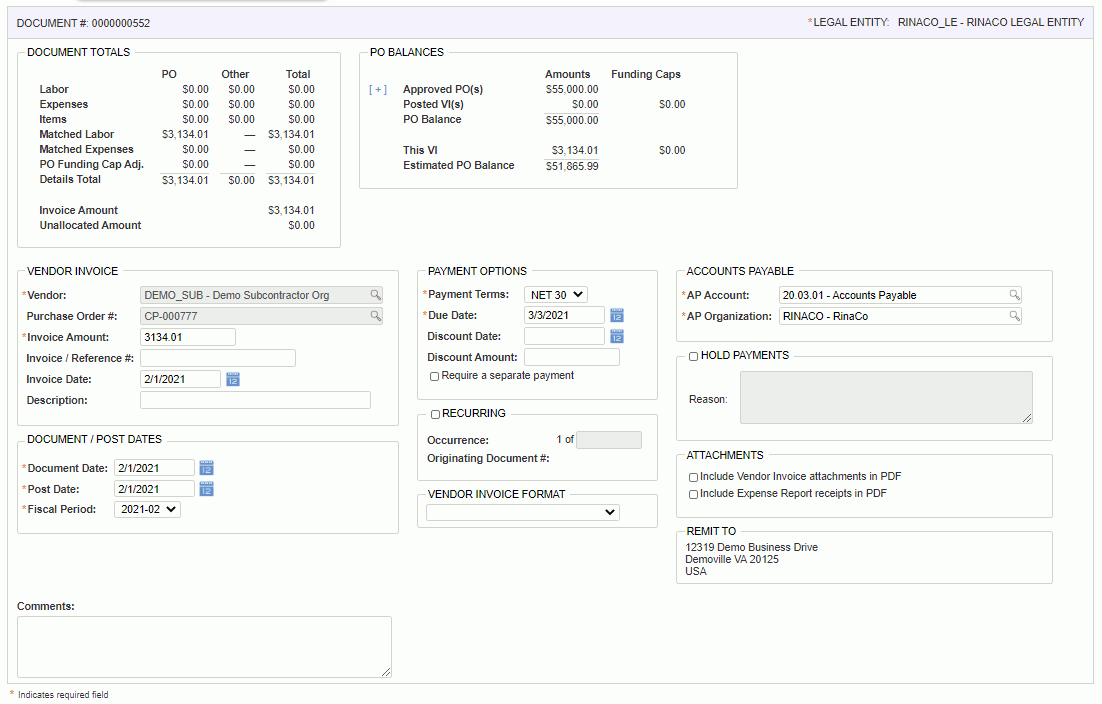
|
|
|
|
|
This screen is available to enter the labor detail line items making up a Vendor Invoice (which you can get to by navigating to the Labor left menu option after clicking the pencil icon from the Vendor Invoice list screen).
The Labor menu option will become unavailable once the Vendor Invoice reaches the POSTED status.
Header
The information in the 'header' section of the screen will recap the information provided on the document Summary, as well as Document Totals and PO Balances (if related to a PO).
Details Grid
This section of the Vendor Invoice Details screen is where you will be entering the individual labor line items that make up the Vendor Invoice. Note that in order to submit or post a Vendor Invoice, the total of the detail lines must equal the Invoice Amount provided on the Summary screen. This screen will include the display of informational error messages to help point out any issues with the current document that would prevent submittal.
For those Accounts that have been designated as requiring Project information (configured on the Admin >> Setup >> Accounts screen with the Require Project indicator checked), you can also provide additional 'reference' information (such as the project, task, project type, labor category, and person).
The Approved PO Labor Lines will display open lines if the VI is related to a PO. You can click on the add detail icon -  - to create a VI line from a PO line. New VI Labor Lines are the lines being added to this VI.
- to create a VI line from a PO line. New VI Labor Lines are the lines being added to this VI.

|
|
|
|
|
This screen is available to enter the expense detail line items making up a Vendor Invoice (which you can get to by navigating to the Expenses left menu option after clicking the pencil icon from the Vendor Invoice list screen).
The Expenses menu option will become unavailable once the Vendor Invoice reaches the POSTED status.
Header
The information in the 'header' section of the screen will recap the information provided on the document Summary.
Details Grid
This section of the Vendor Invoice Details screen is where you will be entering the individual expense line items that make up the Vendor Invoice. Note that in order to submit or post a Vendor Invoice, the total of the detail lines must equal the Invoice Amount provided on the Summary screen. This screen will include the display of informational error messages to help point out any issues with the current document that would prevent submittal.
For those Accounts that have been designated as requiring Project information (configured on the Admin >> Setup >> Accounts screen with the Require Project indicator checked), you can also provide additional 'reference' information (such as the project, task, project type, expense type, and person).
The Approved PO Expense Lines will display open lines if the VI is related to a PO. You can click on the add detail icon -  - to create a VI line from a PO line. New VI Expense Lines are the lines being added to this VI.
- to create a VI line from a PO line. New VI Expense Lines are the lines being added to this VI.
If you delete a Detail line item on a Vendor Invoice that was originally created by the Create Vendor Invoice from Expense Report function, then that Expense Report will once again be eligible to be included in a future Create Vendor Invoice process.

|
|
|
|
|
This screen is available to enter the item detail lines making up a Vendor Invoice (which you can get to by navigating to the Items left menu option after clicking the pencil icon from the Vendor Invoice list screen).
The Items menu option will become unavailable once the Vendor Invoice reaches the POSTED status.
Header
The information in the 'header' section of the screen will recap the information provided on the document Summary.
Details Grid
This section of the Vendor Invoice Details screen is where you will be entering the individual item lines that make up the Vendor Invoice. Note that in order to submit or post a Vendor Invoice, the total of the detail lines must equal the Invoice Amount provided on the Summary screen. This screen will include the display of informational error messages to help point out any issues with the current document that would prevent submittal.
For those Accounts that have been designated as requiring Project information (configured on the Admin >> Setup >> Accounts screen with the Require Project indicator checked), you can also provide additional 'reference' information (such as the project, task, project type, and person).
The Approved PO Item Lines will display open lines if the VI is related to a PO. You can click on the add detail icon -  - to create a VI line from a PO line. New VI Item Lines are the lines being added to this VI.
- to create a VI line from a PO line. New VI Item Lines are the lines being added to this VI.

|
|
|
|
|
This screen is available to attach one or more documents to a Vendor Invoice (which you can get to by navigating to the Attachments left menu option after clicking the pencil icon from the Vendor Invoice list screen).
Users can add attachments regardless of the Vendor Invoice status. Only Administrators can delete attachments when the Vendor Invoice status is Posted or Approved.
Note: The Unanet Administrator may want to suggest guidelines with regards to what types of files may be acceptable to be used as Vendor Invoice attachments, particularly in the case where any documents are being scanned and saved as a graphics file. Certain graphics file formats are known to result in much larger files sizes than others and you may want to consider suggesting a specific file type to help control the amount of data being stored in your database. Generally speaking, jpg and gif files tend to be much smaller than tif and png file formats.
To assist with the management of allowable attachment types and size, the administrator can use the following three properties: Maximum Size Allowed for each attachment (unanet.attachment.max_size), File Extensions that are Not Allowed (unanet.attachment.invalid_file_extensions) and File Extensions that are allowed (unanet.attachment.valid_file_extensions).
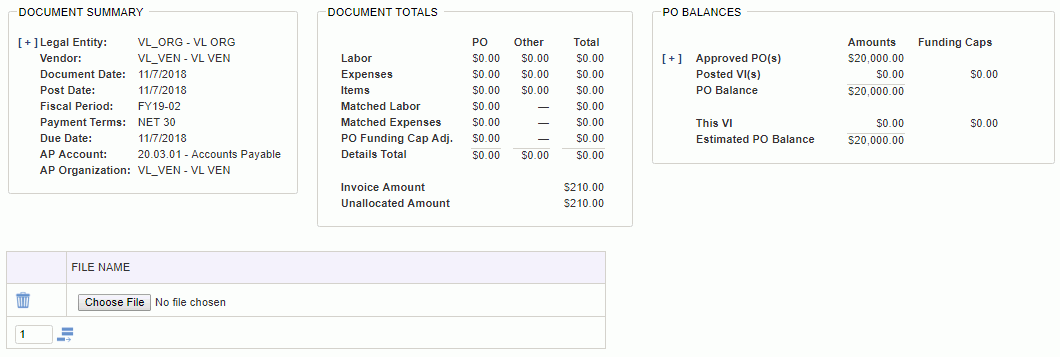
Using this screen, the user can add, remove or view an attachment. The Save button will save the changes to the attachment screen and return the user to the Vendor Invoice Details screen. The Cancel button will also navigate the user to the Vendor Invoice Details screen but without saving any changes. Clicking on the paper clip icon will launch a new window and attempt to display the attachment (assuming your local PC knows what application to execute to view the specific file type).
|
|
Where can attachments be seen?
The Vendor Invoice >> List screen will contain a paperclip (![]() ) icon to indicate attachments exist on a particular Vendor Invoice. Clicking on the icon will navigate the user to the Vendor Invoice >> View screen with the Attachment section expanded.
) icon to indicate attachments exist on a particular Vendor Invoice. Clicking on the icon will navigate the user to the Vendor Invoice >> View screen with the Attachment section expanded.
When viewing a Vendor Invoice that has attachments, the list of attachments will appear in an expandable table under the displayed Vendor Invoice details as in the example below. You can click on the paper clip icon ( ) and view the attached document (assuming you have the necessary local software installed to view the particular file type). This section will only appear if attachments exist.
) and view the attached document (assuming you have the necessary local software installed to view the particular file type). This section will only appear if attachments exist.
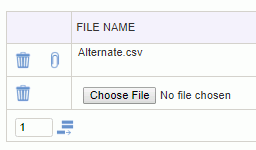
This screen is available to view, add, defer, submit, or post matched labor (i.e., all timesheet lines from Non-Employee (PO) users related to the PO that are in LOCKED or EXTRACTED status). You can get to this screen by navigating to the Matched Labor left menu option after clicking the pencil icon from the Vendor Invoice list screen.
When a VI associated with a PO is created, the matched labor will show on this page. Matched labor lines are those lines associated with the PO where the date is on or before the invoice date, and the timesheet status is LOCKED or EXTRACTED and not in pending adjustment, and it is not associated with another VI. If you change the PO, you must then click on the  icon to pull in the unmatched labor. This is not done automatically.
icon to pull in the unmatched labor. This is not done automatically.
The Matched Labor menu option will become unavailable once the Vendor Invoice reaches the POSTED status.
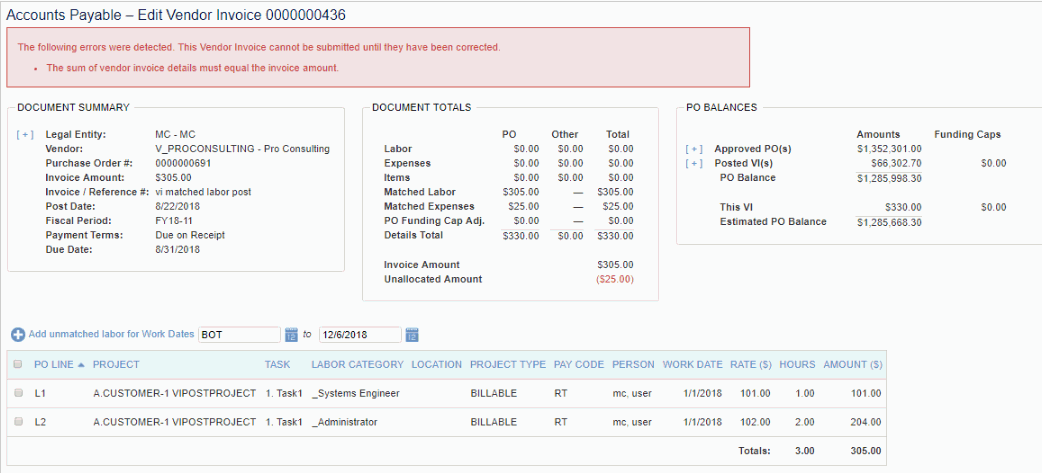
|
|
|
|
|
This screen is available to view, add, defer, submit, or post matched expenses (i.e., all expense reports from Non-Employee (PO) users related to the PO that are in LOCKED or EXTRACTED status). You can get to this screen by navigating to the Matched Expenses left menu option after clicking the pencil icon from the Vendor Invoice list screen.
When a VI associated with a PO is created, the matched expenses will show on this page. Matched expenses are those associated with the PO where the expense date is on or before the invoice date, and the expense status is LOCKED or EXTRACTED , and it is not associated with another VI. If you change the PO, you must then click on the  icon to pull in the unmatched expenses. This is not done automatically.
icon to pull in the unmatched expenses. This is not done automatically.
The Matched Expenses menu option will become unavailable once the Vendor Invoice reaches the POSTED status.
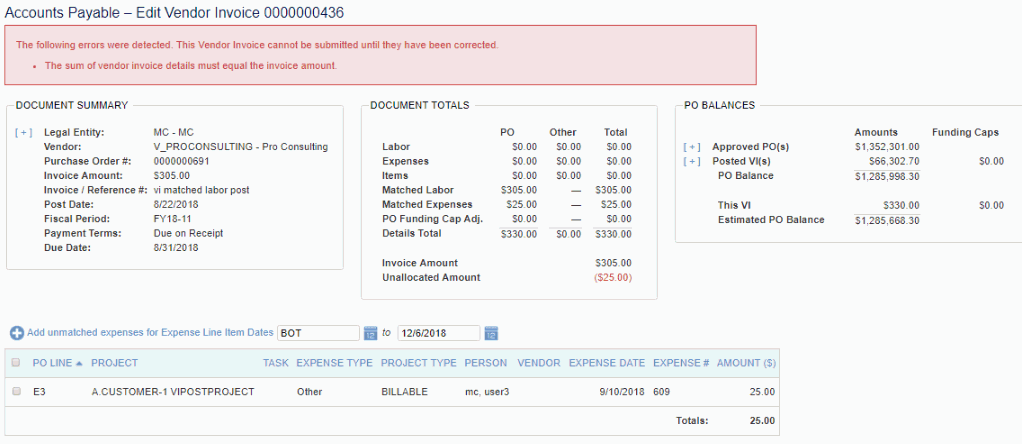
|
|
|
|
|
If a VI is matched to a PO, then PO Funding Cap Adj will be available from the menu. You can view, delete, and calculate PO funding cap adjustments from this screen. You can also submit and post the VI. You must click on the Calculate PO Funding Cap Adj button in order to see funding cap adjustments.
If the related PO Summary or related PO lines have Vendor Invoice Overage field set to "PO Fund Cap Adj.", then you can calculate the funding cap adjustment on this page. A funding cap adjustment basically happens when you overspend the cap amount from the related PO on your VI. The Vendor Invoice can still be submitted, but the overage amount is placed in an at-risk account. When PO funding is increased, the at-risk amount will be automatically reversed on the next VI.
Funding caps are calculated for detail lines first, then calculated for the PO summary.
A basic example is a PO with an amount of $1000, and then a VI created for that PO with the amount of $1020. The funding cap adjustment is then -$20.
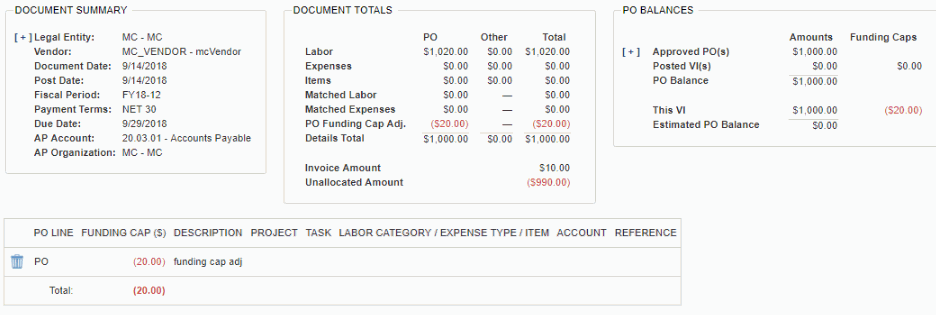
|
|
This screen is available to view a read-only version of the Vendor Invoice document (which you can get to by navigating to the View left menu option after clicking the pencil icon from the Vendor Invoice list screen or by clicking on the view icon on the Vendor Invoice >> List).
Once the Vendor Invoice reaches the POSTED status, this will be the only available menu option. Under Document Totals, the following items will only display if the VI has a PO: Matched Labor, Matched Expenses, and PO Funding Cap Adj.
The Invoice Amount displayed for Project Approvers is the sum of line amounts that are related to the project. The amount displayed for Receiver/Approvers is the sum of line amounts that are related to the Purchase Order.
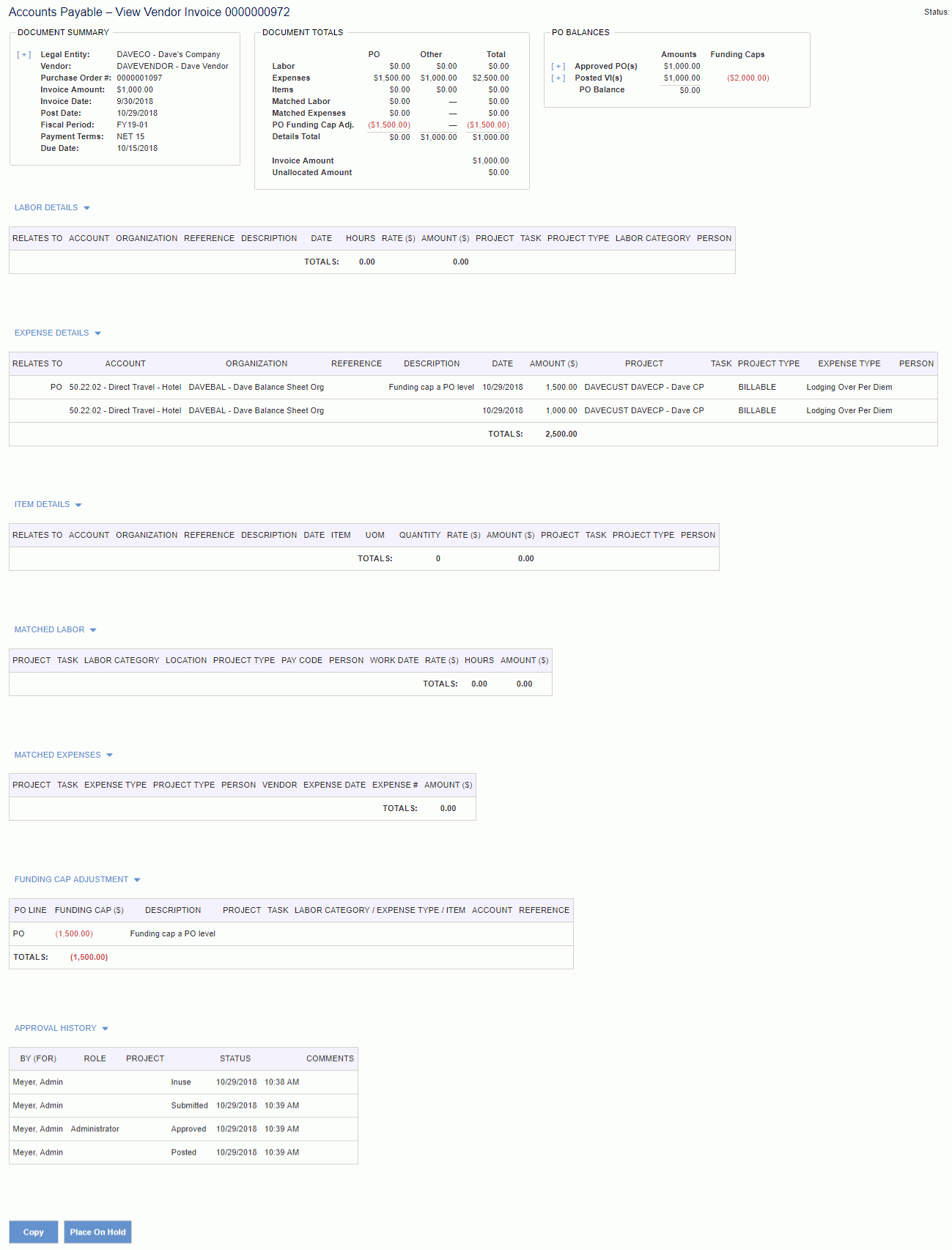
If the user viewing the Vendor Invoice has access to this Vendor Invoice's Legal Entity, a Copy button will be available (regardless of the Vendor Invoice status). If the status is anything other than Posted, an Edit button will also be available as will a Place on Hold or Take Off Hold button.
Note: Being "on hold" merely indicates invoices for a Vendor will not automatically be considered for payment during the Bulk Vendor Payment Creation process. Users can continue to manually issue Vendor Payments via the Vendor Payment screens, though the "on hold" indicator will be displayed for informational purposes.
Place On Hold / Take Off Hold
Once a vendor invoice has reached the SUBMITTED or POSTED status, the ability to further manipulate the "Hold Payment" option will remain. Rather than editing the Vendor Invoice and checking or unchecking the Hold Payment check box on the Summary screen, you can use these buttons to continue to manipulate that option. Only one button will appear at a time depending on whether the Vendor Invoice is current on hold.
Note: Users with VI User role only cannot place on hold/take off hold.
The Copy button is available from the View screen (if the user viewing the Vendor Invoice has access to the Legal Entity of this Vendor Invoice). Once you populate the values on this screen, click on Copy to invoke the copy or Cancel to abandon the copy. Clicking on the Copy option will take you to the newly created Vendor Invoice.
The copy function will create a duplicate of the current Vendor Invoice (including labor/expense/item detail lines) with the following differences:
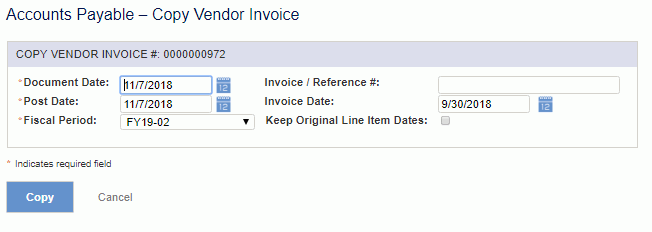
|
|
You will see some widgets at the top of the VI Summary page for your created VI: Document Totals and possibly PO Balances, if the VI is associated with a PO. These widgets provide a snapshot view of the document and balances. The Document Totals widget only shows totals for the current document. The PO Balances widget lists the approved POs, Posted VIs, and related balances.
The Document Totals for Labor, Expenses, Items, Matched Labor and Expenses, and PO Funding Cap Adj. will get updated with the amounts entered for the respective Labor, Expense, Item detail lines, Matched Labor and Expenses, and PO Funding Cap Adjustments.
The detail line and view pages will also display a Document Summary.
See below for specific field descriptions.

|
|
If Vendor Invoice (approval_process.require.approval.vendor_invoice) is set to "Requires Approvals Always", you must choose an approval group when you submit. Following is the process if approval is required:
In order to see a list of approval groups on the submit screen, the submitter on the VI must be a VI Submitter in an approval group. See Accounts Payable Approval Groups.
Note: The VI will be re-validated upon approval. If the VI is no longer valid for approval, it will be automatically disapproved by the system.
Note: Other options for the Vendor Invoice (approval_process.require.approval.vendor_invoice) property include "Conditionally Requires Approvals", "Optional Approvals", and "Disabled Approvals". Please click on the property link for more information.
Note: If the VI is associated with a PO that has a Receiver/Approver assigned to it, then that Receiver/Approver will be assigned as an approver of the VI for the detail lines related to the PO, regardless of approval group settings.
This screen is available to users having any of the following roles: Administrator or AP Poster. Note that AP Posters are limited to posting Vendor Invoices for the Legal Entities they have access to via Financial Organization Access.
Vendor Invoices can be posted from the following screens:
The posting process includes the following (not necessarily generated in this order):
Validations
While you can save a financial document violating certain rules, you will not be permitted to submit or post the document until they are resolved. If any of the validations fail for any row on the document, the entire document cannot be posted.
Standard financial document validations for each Detail row:
This screen is available to users having any of the following roles: Administrator and AP Poster.
Clicking on the Void icon ( ) in the Vendor Invoice List will allow you to void a POSTED Vendor Invoice (generating a negating / voiding Vendor Invoice, reversing GL and Project Expense entries, etc). This action does not delete any entries nor will it recalculate any values, but rather creates a set of reversing entries based on the original transactions. This is true even if attributes referenced in the original documents have subsequently been made inactive, the voided transaction will continue to use those attributes to reflect the reversing values.
) in the Vendor Invoice List will allow you to void a POSTED Vendor Invoice (generating a negating / voiding Vendor Invoice, reversing GL and Project Expense entries, etc). This action does not delete any entries nor will it recalculate any values, but rather creates a set of reversing entries based on the original transactions. This is true even if attributes referenced in the original documents have subsequently been made inactive, the voided transaction will continue to use those attributes to reflect the reversing values.
A voiding vendor invoice is treated as the equivalent of a payment application in regards to the originating vendor invoice (e.g. it would typically take the vendor invoice outstanding balance down to zero). Note, however, that it can also take the amount of the vendor invoice below zero (or above zero if the voided document was originally a negative document) in those cases where the original document has already been included in one or more vendor payments.
The posting process includes the following:
Validations
To void a Vendor Invoice, you will need to supply values for the following fields and click on the Void button.
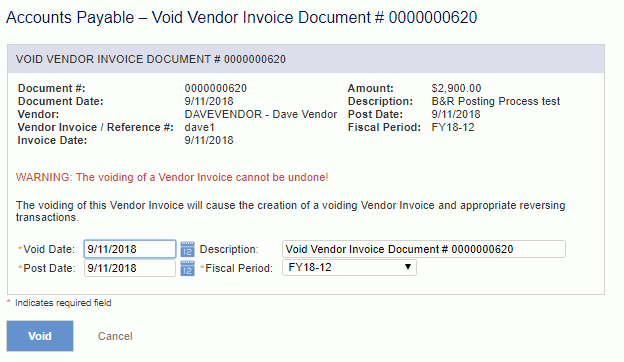
|
|
Posting to Closed Fiscal Year
When posting to or voiding a document from a closed fiscal year, and the document contains details for accounts having account types REVENUE and EXPENSE, where the credits and debits do not cancel each other out (i.e. the delta between the revenues and expenses is not = 0), this process will additionally need to generate an adjustment to the previously recorded RETAINED EARNINGS account for the closed year.
Note the adjustment will be generated regardless of the existence of the RETAINED EARNINGS account for the year being adjusted.
The adjusting transaction will have the following attributes: